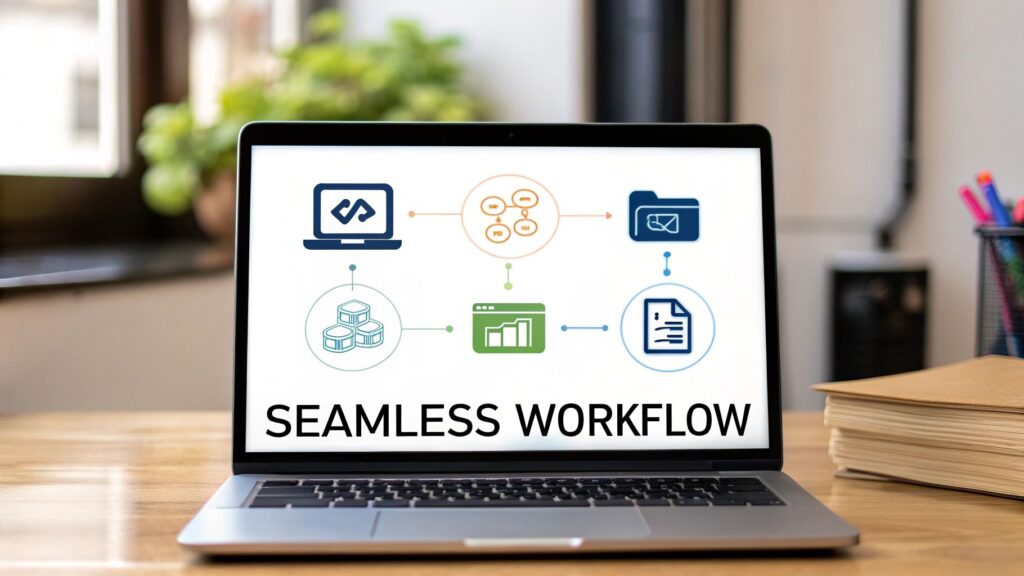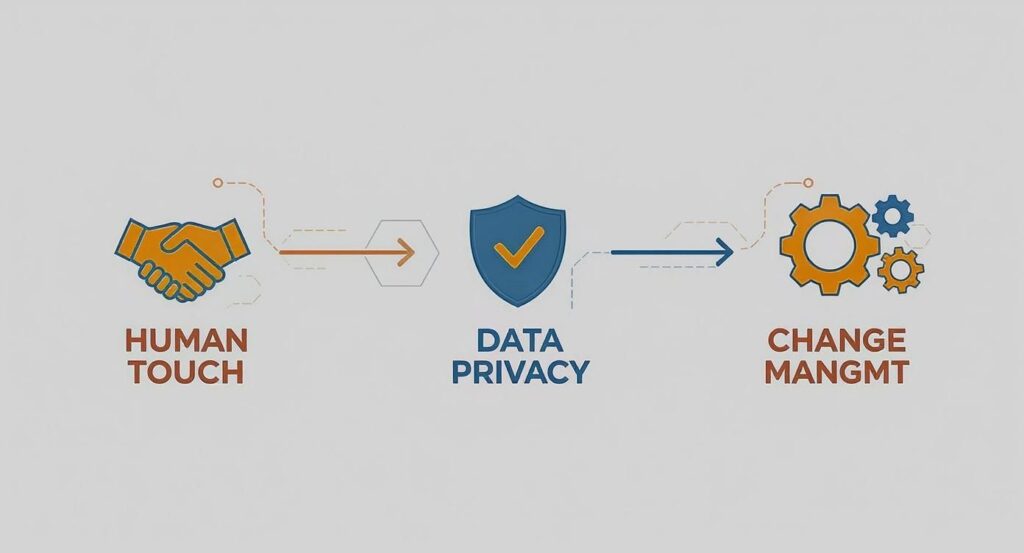Think of a virtual hiring platform as a digital command centre for your entire recruitment process. It takes hiring out of messy spreadsheets and endless email chains, pulling everything from candidate sourcing to onboarding into one cohesive system. For large-scale hiring, this makes the whole operation faster, smarter, and driven by data.
The New Era of Recruiting in India

Let’s be honest, the old ways of recruiting just don’t cut it anymore. The traditional approach—bogged down by manual tracking, inconsistent evaluations, and being tied to one location—is simply not sustainable for modern Indian enterprises.
Today, the pressure is on. We need to hire top talent at scale and ensure a great candidate experience. This isn’t a small task; it demands a complete strategic overhaul. This is exactly where a virtual hiring platform stops being a “nice-to-have” and becomes a strategic necessity.
Recruitment is no longer a reactive function buried in admin. It’s a proactive, data-backed business driver. Imagine having a single source of truth that gives you a crystal-clear view of your talent pipeline, assessment scores, and interviewer feedback. That visibility is the key to making smarter, faster, and less biased hiring decisions.
Key Drivers for Adoption
Several powerful forces are pushing Indian companies towards these centralised digital hiring solutions. The massive shift to remote and hybrid work has made in-person interviews impractical, forcing organisations to find better ways to assess candidates from anywhere in the country. Suddenly, the talent pool isn’t just your city; it’s the entire nation.
At the same time, there’s a growing demand for data. CHROs are now expected to back up hiring decisions with hard numbers, moving beyond gut feelings. A robust virtual hiring platform delivers the analytics needed to measure what’s working, spot bottlenecks, and constantly fine-tune the recruitment process for better results.
The market numbers tell the same story. The recruitment software market in India, valued at USD 80.0 million in 2024, is set to climb to USD 120.0 million by 2033. This isn’t just a trend; it’s a major investment wave across Indian enterprises. You can dig deeper into this data with the IMARC Group’s comprehensive report.
This technology fundamentally redefines recruitment. It’s not just about digitising old processes; it’s about re-engineering the entire talent acquisition function to be more agile, intelligent, and aligned with core business objectives.
Moving from Reactive to Proactive
Ultimately, adopting a virtual hiring platform is about securing a competitive edge. It gives HR leaders the power to anticipate hiring needs, build talent pipelines long before a role opens up, and engage top candidates in a more meaningful way.
This proactive stance means your organisation is always ready to bring in the skills needed for growth. It transforms recruitment from a cost centre into a strategic pillar of your business’s success.
Core Features of a Modern Hiring Platform

A top-tier virtual hiring platform isn’t just a random collection of digital tools. Think of it more like a high-performance engine, where every single component is engineered to work in perfect harmony to drive the entire recruitment lifecycle forward.
The real magic happens when these core features sync up, creating a completely seamless journey for everyone involved—from a candidate’s first click to their first day on the job. Let’s break down the essential pillars that make this all possible.
Candidate Sourcing and Engagement
Finding and attracting the right talent is always the first hurdle. A modern platform completely overhauls this function, moving far beyond just posting a job ad and hoping for the best. It acts as a central command hub, plugging into multiple channels to cast a much wider, smarter net.
This pillar is all about features that proactively seek out and engage potential hires. The goal isn’t just to fill an open role today, but to build a rich pipeline of talent for tomorrow.
- Automated Job Postings: Imagine pushing your job openings simultaneously across dozens of platforms—major Indian job boards, professional networks like LinkedIn, and even niche industry sites—with a single click.
- AI-Powered Candidate Matching: This is where the tech really shines. Smart algorithms scan massive resume databases and professional profiles to pinpoint candidates whose skills and experience are a perfect match for your needs, often uncovering hidden gems and passive talent you’d otherwise miss.
- Centralised Talent Pools: Build your own proprietary database of past applicants, promising “silver medallists,” and referred candidates. Nurturing this internal pool means you can often fill new roles without ever having to look outside.
Intelligent Screening and Assessment
Once you have a pool of candidates, the platform gets to work on evaluating them efficiently and fairly. This is a game-changer, replacing the soul-crushing manual resume reviews with objective, data-driven screening. The aim is to quickly surface the most qualified people while stripping out unconscious bias from the process.
A key function of a leading virtual hiring platform is to standardise the evaluation criteria. This ensures every candidate is assessed against the same benchmarks, leading to fairer outcomes and higher-quality shortlists.
For example, AI-powered screening can parse thousands of resumes in minutes, ranking them based on predefined criteria like specific skills, years of experience, and qualifications. This frees up your recruiters to do what they do best: engage with top-tier candidates instead of getting bogged down in administrative quicksand.
Collaborative Interviewing Tools
The interview stage is where the human connection is critical, and a virtual platform is built to make that happen seamlessly, no matter where your team or candidates are located. It goes way beyond a simple video call, providing a structured and collaborative space for your hiring teams to work together.
Common Interviewing Features:
- One-Way Video Interviews: Candidates record answers to a preset list of questions on their own time. This is perfect for flexible, high-volume screening.
- Live Video Interviews: Think integrated video conferencing packed with features like shared scorecards, real-time note-taking, and question banks to keep every interview consistent and on track.
- Automated Scheduling: The platform can sync with your team’s calendars and let candidates pick their own interview slots, ending the endless back-and-forth emails that slow everything down.
This coordinated approach ensures all feedback is captured in one place, giving you a 360-degree view of each candidate. You can learn more about how a top-tier recruitment platform eases digital hiring challenges in our detailed guide.
Integrated Onboarding Workflows
Finally, a truly comprehensive platform doesn’t just stop when an offer is accepted. The best systems see the journey through, extending into the onboarding process to ensure a smooth, positive transition for your new hire. This integration is vital for keeping the momentum going.
This final pillar automates all the administrative headaches of bringing a new person into the company. It directly connects the recruitment function with HR operations, making sure all the necessary paperwork, IT setup, and initial training modules are sorted before the employee even walks through the door. It’s the final piece of the puzzle, creating a cohesive and welcoming journey from applicant to valued team member.
Key Business Advantages for Your Organization
Bringing a virtual hiring platform on board is much more than a simple HR tech upgrade. It’s a strategic move that delivers real, measurable value straight to your bottom line. For any CHRO in India, the right platform can transform recruitment from a cost centre into a genuine engine for growth, efficiency, and brand power.
Think of it as the difference between just filling open positions and proactively building a competitive edge through smarter, faster talent acquisition. The real magic happens when you turn every stage of the hiring journey into a streamlined, data-driven operation. This shift unlocks some serious benefits, from slashing costs to building an employer brand that top candidates actively seek out.
Let’s break down the tangible results you can expect.
Shatter Geographical Barriers to Talent
For years, hiring in India was tied to a physical location. Your talent pool was pretty much limited to the city your office was in, forcing you to fight over the same local candidates as every other company. Virtual hiring platforms completely tear down these walls, opening up the entire country as your talent pool.
Imagine you need to hire a specialised cloud engineer. Instead of being stuck looking only in Bengaluru or Hyderabad, you can now seamlessly assess, interview, and hire the absolute best person for the job, whether they’re in Jaipur, Kochi, or anywhere in between. This isn’t just a minor tweak; it’s a fundamental change in how you access critical skills.
The moment you remove the need for candidates to travel for an interview, you make your opportunities available to a much wider, more diverse group of professionals. This directly translates to finding higher-quality people who were previously out of reach.
Expanding your hiring footprint like this is essential for scaling your business. We’re already seeing this shift play out across the Indian job market. Recent data shows that 72% of employers in India are planning to expand their workforce, with a sharp focus on tapping into talent from non-metro regions. You can dive deeper into these recruitment dynamics in Naukri’s latest Hiring Outlook report.
To really grasp the shift, let’s compare the old way with the new.
Comparing Traditional vs Virtual Hiring Processes
This table shows just how much changes when you move from a manual, location-based process to a unified virtual platform.
| Recruitment Stage | Traditional Process | Virtual Hiring Platform Process |
|---|---|---|
| Sourcing | Limited to local job boards, physical events, and local networks. | Access to a nationwide, even global, talent pool. |
| Screening | Manual resume review, often slow and prone to bias. | AI-powered screening identifies top candidates in minutes. |
| Interviews | Logistical nightmare of scheduling, travel, and room bookings. | On-demand and live video interviews, with self-service scheduling. |
| Assessments | In-person tests, difficult to standardise and scale. | Integrated, proctored online assessments for consistent evaluation. |
| Candidate Experience | Often slow, fragmented, and impersonal. | Seamless, professional, and engaging digital experience from start to finish. |
| Data & Analytics | Fragmented data, difficult to track key metrics like time-to-hire. | Centralised dashboard with real-time analytics on all KPIs. |
The contrast is clear: virtual platforms replace logistical hurdles with automated efficiency at every step.
Dramatically Reduce Time to Hire
One of the first things you’ll notice is how quickly your time-to-hire drops. Traditional hiring is notoriously slow, weighed down by endless back-and-forth scheduling, travel plans, and disconnected communication. Every single delay costs you in lost productivity and, worse, risks you losing your best candidates to a faster competitor.
A virtual hiring platform puts the most time-consuming tasks on autopilot:
- Automated Screening: AI-driven tools can sift through thousands of applications in the time it takes to have a cup of tea, flagging the best-fit candidates way faster than any human team can.
- Self-Service Scheduling: Candidates can book their own interview slots from a calendar, killing the frustrating email chains between recruiters, candidates, and hiring managers.
- Concurrent Interviews: You can run multiple interview rounds with different teams at the same time without any logistical clashes.
This speed means you can take a candidate from application to offer in a fraction of the time. You secure top talent before anyone else even gets a chance. These efficiencies are magnified even further when you integrate technology with recruitment expertise through digital RPO for high-impact hiring.
Enhance Quality of Hire and Employer Brand
Finally, a polished digital process has a direct impact on the quality of your hires and your reputation in the market. Using standardised assessments and structured video interviews ensures every candidate is measured against the same objective yardstick. This reduces unconscious bias and puts the focus squarely on skills and competence, leading to better long-term hiring decisions.
At the same time, a smooth, professional, and modern hiring experience leaves a great impression on every single applicant—even the ones you don’t end up hiring. This positive candidate experience is gold for building a strong employer brand. Today’s top talent expects a digital-first approach; providing one shows your organisation is forward-thinking and values its people right from the first hello.
Navigating Implementation Challenges and Risks
Adopting a virtual hiring platform can bring massive wins, but let’s be realistic—the path to a successful rollout isn’t always a straight line. Like any big operational change, implementing new technology comes with its own set of potential speed bumps. The key to unlocking the platform’s full potential is to anticipate these risks and tackle them head-on.
The most successful rollouts are the ones where leaders see these obstacles coming. From keeping a personal connection with candidates to getting your own team on board, you need a clear strategy. Think of these challenges less as roadblocks and more as essential checkpoints for building a hiring process that’s both digital and resilient.
Preserving the Human Touch in a Digital Process
One of the biggest worries we hear from HR leaders is that automation will make hiring feel cold and impersonal. That’s a valid concern. A virtual hiring platform should support human connection, not get rid of it. The whole point is to automate the tedious administrative tasks so your recruiters can spend more quality time with top-tier candidates.
But if you’re not careful, a purely digital process can feel like a black hole for applicants. It’s crucial to design a journey that feels supportive and personal, even when it’s powered by tech.
Here’s how you can get it right:
- Personalised Communication: Sure, use automated templates for speed, but make them customisable. A quick message addressing a candidate by name and mentioning a specific skill from their CV makes all the difference.
- Clear Expectations: Give candidates detailed guides on what to expect. Tell them how the video interview tool works or what the next steps are. This simple act of transparency reduces anxiety and builds a huge amount of trust.
- Recruiter Accessibility: Make sure candidates know who to contact. Even with slick automated systems, just knowing a real person is there to answer questions is vital for a positive experience.
The ultimate test of any virtual hiring platform is whether it actually improves the candidate experience. Technology should remove friction and frustration, creating a smooth, respectful journey that strengthens your employer brand with every single interaction.
Ensuring Data Privacy and Security
In India, data privacy is a board-level conversation. A virtual hiring platform will handle a massive amount of sensitive candidate information, from personal details to assessment scores. Protecting this data isn’t just good practice; it’s a legal and ethical must-have.
Your chosen platform absolutely must have rock-solid security protocols. This means end-to-end encryption for all communication and data storage that complies with local laws like the Digital Personal Data Protection Act. A data breach could cause irreparable damage to your brand’s reputation and lead to serious legal trouble.
Overcoming Internal Resistance and Driving Adoption
This might just be the biggest risk of all: resistance from your own team. Your recruiters and hiring managers are used to doing things a certain way. Throwing a new platform at them means they have to learn new processes, and that can be met with scepticism—or even outright pushback—if it isn’t handled correctly.
Successful change management is the foundation of any tech implementation. It’s about so much more than just training; it’s about building advocates and showing people exactly what’s in it for them.
Key steps for driving adoption:
- Involve Stakeholders Early: Bring your hiring managers into the selection and customisation process from day one. When they feel a sense of ownership, they’re far more likely to become champions for the new system.
- Showcase “What’s In It For Them”: Don’t just talk about company benefits. Frame the platform in terms of their daily work. Show them how it will save them time, cut down on admin headaches, and help them find better candidates, faster.
- Provide Comprehensive Training: Offer hands-on, role-specific training sessions. Go beyond just showing them how to use it—explain the why behind the new processes to build real understanding and buy-in.
A Roadmap for Successful Platform Implementation
Shifting to a new virtual hiring platform is a big move, but it doesn’t have to be a massive headache. With a clear, structured roadmap, you can turn this project from a daunting task into a manageable and highly successful one. Think of this as your practical, step-by-step playbook for a smooth rollout.
The real work starts long before you “go live.” A successful launch is built on a solid foundation of careful planning, cross-functional teamwork, and a real understanding of what your organisation needs to achieve with its hiring.
Phase 1: Laying the Groundwork
First things first: you have to define what success actually looks like for your team. Are you aiming to slash time-to-hire by 30%? Maybe you want to tap into talent pools in new regions or simply improve the quality of candidates making it to the final round. Setting clear, measurable goals from the start will guide every decision you make down the line.
Once your goals are set, it’s time to assemble your implementation team. This can’t just be an HR project; you need buy-in from across the business to make it stick.
- Project Lead (HR): The person who oversees the entire process and keeps it aligned with your recruitment strategy.
- IT Specialist: Your go-to for all the technical bits, from system integrations to data security.
- Hiring Manager Champions: Key representatives from different departments who will actually use the platform. Getting them involved early is crucial for adoption.
- Finance Representative: Someone to keep an eye on the budget and help calculate the return on investment later on.
This mix of expertise ensures all angles are covered, paving the way for a much smoother, company-wide rollout. For more practical advice, take a look at our article on the 7 steps for digital hiring with recruitment technology.
Phase 2: Execution and Integration
With your team and goals locked in, the focus shifts to the technical side of things. This is where your new virtual hiring platform starts talking to your existing HR tech stack. A major milestone here is data migration—moving all your candidate records, job descriptions, and past hiring data over to the new system. This step needs to be handled with extreme care to avoid any disruptions.
A smart move is to launch a pilot programme with just one or two departments before going all-in. This controlled test run lets you iron out any kinks, get honest feedback from users, and fine-tune your training materials in a low-risk environment.
Think of the pilot programme as your implementation’s dress rehearsal. It shows you what works on paper versus what works in practice, allowing you to perfect the process and build confidence before the main event.
Phase 3: Training and Go-Live
As you gear up for the full launch, remember that even the best platform is worthless if your team doesn’t know how to use it. You’ll need to develop comprehensive, role-specific training. How a recruiter uses the system will be very different from how a hiring manager does. Focus on hands-on, practical sessions that show them exactly how the platform makes their day-to-day jobs easier.
A solid communication plan is just as vital. Keep the whole organisation in the loop about the upcoming changes, highlighting the benefits and managing expectations. This kind of proactive communication can turn potential resistance into genuine excitement.
This simple flow shows the core challenges—balancing that essential human touch, nailing data privacy, and managing the change—that your implementation roadmap must address.

Getting these areas right is the key to a smooth transition and ensures the platform starts delivering value from day one.
Measuring Your Hiring ROI and Key KPIs

Let’s be honest: bringing in a virtual hiring platform is a significant investment. To get buy-in and prove its worth, you need to move past the anecdotes and show stakeholders a clear, data-backed financial story. That means tracking the right Key Performance Indicators (KPIs) and nailing down a tangible Return on Investment (ROI).
Think of your platform’s analytics dashboard as the cockpit of your recruitment engine. It gives you the hard data you need to show impact, justify the tech spend, and lock in your budget for next year. Without these numbers, you’re essentially flying blind, hoping the strategic shift is paying off.
Essential KPIs to Track
To build a convincing business case, you need to zero in on a core set of metrics that tell the story of efficiency, cost, and quality. A solid virtual hiring platform makes this easy, automatically pulling all the data you need into one central dashboard.
These four KPIs are the foundation of any good measurement strategy:
- Time-to-Fill: This is the big one. It tracks the total number of days from when a job req is opened to the moment an offer is accepted. A sharp drop here is the clearest sign that your platform is speeding up the entire hiring cycle.
- Cost-per-Hire: This is the total recruitment cost divided by the number of hires you make. Your platform directly attacks this number by cutting out things like advertising spend, travel expenses, and countless hours of administrative work.
- Quality of Hire: This is often measured by looking at performance review scores or retention rates for new hires after their first year. Better screening and standardised assessments should lead to better employees who stick around longer.
- Candidate Net Promoter Score (cNPS): This metric gauges how candidates feel about your hiring process by asking a simple question: “How likely are you to recommend our hiring process to others?” A high cNPS is a great indicator of a positive brand experience.
Calculating Your Return on Investment
Calculating ROI is the ultimate proof of your platform’s financial value. It’s not just about cost-cutting; it’s about capturing the value created through greater efficiency and better hiring outcomes. The formula might look simple, but the real work is in identifying all the gains.
The ROI formula is: ROI = (Net Gain from Investment / Cost of Investment) x 100. A positive ROI means the platform is generating more value than it costs.
To figure out the “Net Gain,” you’ll need to quantify both the hard savings and the softer benefits.
Hard Savings (Direct Cost Reductions):
- Reduced Advertising Spend: Tally up the savings from consolidating job board subscriptions and leveraging the platform’s own sourcing tools.
- Elimination of Travel Costs: Add up every rupee previously spent on flights, hotels, and expenses for candidates and interviewers.
- Decreased Administrative Overhead: Put a value on the recruiter hours you’ve saved by automating scheduling, screening, and communication.
Soft Gains (Indirect Value Creation):
- Increased Productivity: What’s the value of filling roles faster? For a revenue-generating position, it’s the daily revenue that role brings in, multiplied by the number of days you shaved off the Time-to-Fill.
- Improved Retention: Don’t forget the massive cost of employee turnover. If your platform improves Quality of Hire and boosts retention by even a small percentage, the savings are huge.
When you bring all these figures together, you can tell a powerful financial story. You’re not just buying software; you’re investing in a system that delivers measurable savings, boosts productivity, and builds a stronger talent pipeline for the future.
Ready to transform your recruitment process with a data-driven, efficient virtual hiring platform? Discover how Taggd can help you attract, assess, and hire top talent at scale. Explore our solutions at Taggd and build your future-ready workforce today.








